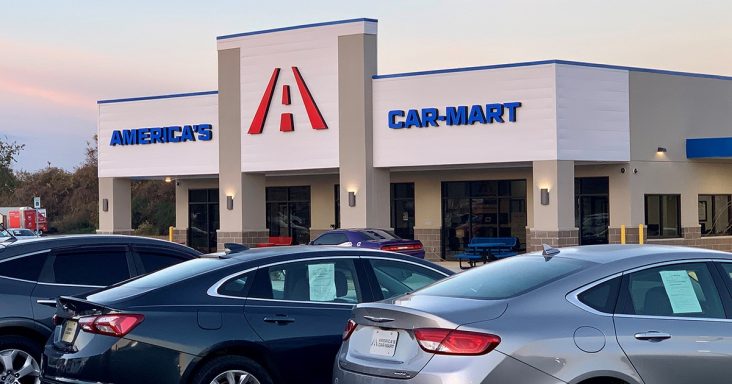Car-Mart earnings to fall, revenue to rise in 2Q of fiscal 2023
by November 9, 2022 3:20 pm 1,200 views

Rogers-based America’s Car-Mart Inc. is expected to post a double-digit earnings decline and a double-digit revenue increase in the second quarter of fiscal 2023 as the evolving automotive market has offsetting impacts on the buy here, pay here used car dealer.
After the markets close on Nov. 16, Car-Mart is expected to report earnings per share declined to $2.17 in the period ending Oct. 31, from $3.33 in the same period last year, based on a consensus of four analysts. Revenue is projected to rise by 13.3% to $326.72 million from $288.3 million.
In an earnings preview, equity analyst John Hecht and equity associates Matthew Hurwit, Sagiv Hartmayer and Ibrahim Kargbo, all of Jefferies LLC, expect revenue to rise as a result of elevated used car prices, despite softening sales volumes. They expect the cost of sales to be $189 million, reflecting a gross profit margin of 35.7%, down 1.74 percentage points from the same period last year. Selling, general and administrative expenses are projected to rise by 19% to $44 million.
Loss rates are expected to rise by 0.78 percentage points “on higher frequency and severity, resulting in a provision expense of $84 million, up 37% (year-over-year),” according to the analysts. “Taken together, this results in total expenses of $326 million, up 26% (year-over-year).”
Vehicle sales are projected to rise by 2.5% to about 15,000 vehicles from the same period last year. The average sales price is expected to rise by 15% to about $18,600 “as pricing continues to be stickier than anticipated and continually impacted by inflationary and supply chain disruptions,” the analysts said.
High used car prices have affected Car-Mart’s financial results in recent quarters, according to the analysts. “Despite the tough market backdrop, (Car-Mart) remains well positioned competitively vs. indirect lenders and other (buy here, pay here) operators. Credit trends have been normalizing on a frequency basis, and we could see incremental pressure on the severity side of the equation as used car prices normalize.
“We believe the current macro backdrop emphasizes (Car-Mart’s) value proposition as an affordable used car dealer,” the analysts added. “We anticipate market share gains as customers from above (Car-Mart’s) typical credit box flow to the company’s lots as traditional lenders tighten underwriting.”
According to the analysts, the evolving used car market is expected to have offsetting effects on Car-Mart, such as used vehicle prices leveling off. At the same time, the tighter credit environment should support sales.
According to the Manheim Used Vehicle Value Index, wholesale used-vehicle prices fell by 2.2% in October from September. It was the fifth consecutive monthly decrease. The October index is down 10.6% from the same month in 2021.
Jonathan Smoke, the chief economist for Cox Automotive, said wholesale price declines were above average for the first time this fall.
“That is happening while supply is in balance, and it appears to be because of rising interest rates impacting affordability,” said Smoke, adding that new vehicle demand has improved, while used vehicle demand has slowed.
Dealertrack metrics show new retail sales were down 10% as of Nov. 5, from the same time last year, while used retail sales were 13% lower. New vehicle supply increased by six days, and used inventories declined by three days, according to vAuto data.
In research on the U.S. auto finance industry, the Jefferies analysts said “a cycle is underway in auto finance. A combination of normalizing credit, slowing sales despite persistently low inventory, affordability issues, rising rates and declining support from residual values will impact margins, volumes and provisioning for the outlook. Residual values are dropping at an unprecedented rate. Risks are increasing.”
The analysts said that industry sales volumes are projected to be affected for the remainder of 2022 due to affordability and supply issues. In the second quarter, the average new vehicle loan amount rose by 12% to nearly $40,000, while the average used vehicle loan increased by 25% to $27,000. The average monthly payment for new vehicle loans increased to $667 from $582, while the average for used vehicles rose to $515, from $440.
According to the analysts, loan term lengths have been rising to offset larger loan amounts, creating more risk. Credit normalization is expected to accelerate and might appear to deteriorate in some categories outside of prime. The average loan rate for used vehicles rose by 0.03 percentage points to 8.62%. Rates for the used sub-prime and deep sub-prime segments experienced a decrease of 0.48 percentage points and 0.29 percentage points, respectively.
“The easy days are in the rearview mirror,” the analysts said. “But the sentiment is aligned with challenging times, and equity values are also reflective of the narrative.”
The analysts reduced Car-Mart’s 12-month target price to $68 from $105 and maintained a hold rating on the stock.
Shares of Car-Mart (NASDAQ: CRMT) closed Wednesday (Nov. 9) at $65, down $1.44 or 2.1%. In the past 52 weeks, the stock has ranged between $58.67 and $129.50.
